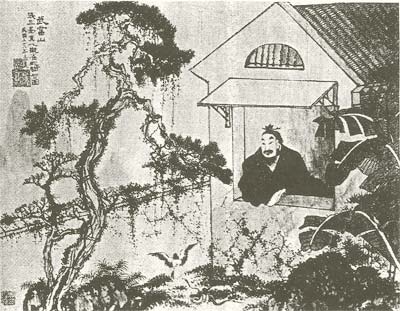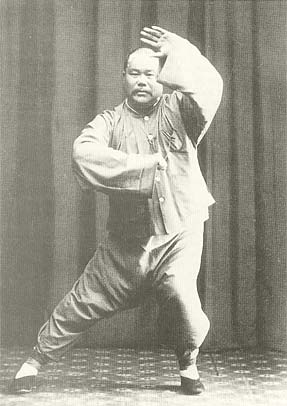T’ai Chi Ch’uan
The name Tai Chi comes from the Chinese philosophy of Tao and means “Great Ultimate” actually. Great Ultimate, a classical name in Chines philosophy, is widely used to describe things and different ways of life. It is also the term for the unity of the universe by describing Yin and Yang, which are opposite powers in the universe.
|

|
Tai Chi Chuan, abbreviated Tai Chi (also Tai-Ji, Tai-Ji-Quan, Taijijuan and Taijiquan) are the only and original names for the movement art. These names are the guarantee* that the teacher teaches the original Tai-Chi, as it was passed on to us from the old Chinese masters.
We know the following styles (forms) according to Chinese traditions:
Chinese masters improved Tai Chi Chuan until it reached perfection for several generations, and have kept it pure for further generations.
The old styles Chen, Yang and Wu (Hao) are still being passed on unaltered today. They differ from each other especially, because the individual movements are different. Where the philosophy of the founders of Chen was to make their style 50% hard and 50% soft, the philosophy behind the Yang style is to be 100% soft. Thereby the first Yang-Style teachers were approaching the Taoist philosophy of “Softness will always overcome hardness and stiffness.”
As regards the length of the styles, Chen has 83 movements, Wu 96. Yang Style consists of 108 movements (see further down).
Peking-Style, also called 24-style or “Simplified Tai Chi”, was invented only in the last 50 years, that means in the time of Maoism. It is a style, where one tried to develop a new style from those already existing. It consists of 24 movements. Thereby the duration is limited to about 5 minutes for the completion of the whole Peking-Form. Compare: With Yang Style one reaches about 20-45 minutes depending on the speed.
In Tai Chi Chuan we learn to know our body better. Tai Chi is an old Chinese “slow martial art”. In China Tai Chi Chuan is being trained everywhere. Tai Chie is inspired by the old Taoist tradition, partly even by the teachings of Confucius. You could also call Tai Chi “Meditation in Movement”. The movements are performed in a flowing and rhythmic, as well as controlled way. The student needs neither power nor strength and the muscles are soft. The breath is deep and regular.
The Tai Chi-performer keeps his body upright and moves easily. Classical Chinese writings describe the movements like that: “make your steps as silent as the pace of a cat” and “if you use strength, it will be so mild that it looks like the red silk being unwound from the cocoon of a silkworm.”
The spirit is silent, but wide-awake. The movements are consciously steered by the performer, so that a unity of static and dynamic is created. Therefore Tai Chi demands a combination not only of physical training, but also of will- and breath training.
The style having been practised for some time, Tai Chi will let your body function as a whole. Hands, eyes, body, legs and feet perform the movements with your waste as axis. Although the movements are easy and slow, all the parts of the body are always active. The energy flow (Chi) created through these flowing movements, stimulates and activates the muscles, the acupuncture meridians, as well as the inner organs. No part is over-stimulated. Your breath adapts naturally and automatically to the movements.
The body is strengthened from inside to outside and thus reaches a very high mobility, without the heart having to work more. You learn to relax, so that the energy flow (Chi) can freely circulate. Therefore you can find your personal, natural condition in Tai Chi.
The most practised Tai Chi-style in the western hemisphere is the long Yang Style, also called “Great Frame” (Tai Chi Chuan Yang Shih). The Yang-family has practised this style for about 200 years. It is the so-called “Slow Set”, that means the original slow Tai Chi. It consists of 108 movements (89 and repetitions) with poetical names like “white crane spreading its wings”, “beat the tiger”, “double wind through the ears” and “Jade woman is weaving”.
 Yang Cheng Fu (1883-1936) |
Tai Chi Chiuan and Kung Fu have the same roots. It is a science where you are active not only physically, but also mentally. Although having learned the movements in a slow way, the Tai-Chi performer will be able, after a certain time, to perform the movements automatically in an explosive manner if getting attacked. Therefore the character of defence of any movement will always be demonstrated in a course.
Through the high concentration, which is necessary in Tai Chi Chuan, the central nerve system will profit. Tai Chi is therefore successfully applied against certain nervous and mental illnesses. Everyone, who knows Tai Chi-performers, can observe, too, that the breathing process gets retarded with people who have been practising for some years. Tai Chi gives on top of that:
 |
|
A man is born gentle and supple
Therefore stiffness and inflexibility are heralds of death.
A tree that doesn’t bow to the wind is easily broken.
Lao-Tse: Tao Te-King |
| Top |